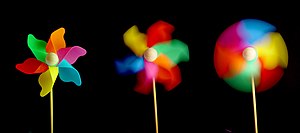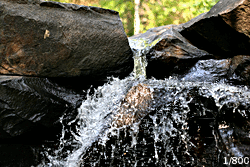 Image via Wikipedia
Image via WikipediaHere, the author cites the number as 10, so there are 10 photography terms that you should know, to help you in your SLR photography journey.
Here goes:
10 Photography Terms You Should Know
Terminology is key to any form of photography. Know your terms and what you can do with those functions or features and your photographic world opens up to you. Terms are easy to learn. What is a challenge is to make use of what these terms describe.
Getting to grips with your terminology really frees you up to grow on your photographic journey. It may not seem necessary but join a group of avid photographers and you will soon realise your lack. So let's have a look at my top 10 terms you should know.

Aperture is the size of the lens opening that determines how much light reaches the digital sensor or film in an SLR camera. It is measured in f-stops ranging from f1.2 to f32.
2. Shutter speed
How fast the shutter opens. It also determines for how long the sensor or film is exposed to the light.
3. ISO
This is the sensitivity to light of a digital sensor or the film in an SLR camera. The higher the ISO, the higher digital noise in a digital image or the grain in a film image.

When a camera light meter sets the exposure on a camera, it is sometimes not 100% correct. It either overexposes or underexposures. In order to correct this there is a setting called exposure compensation which allows you to change the exposure by stops of a third to half to a full stop.
5. Depth of field
This is the depth of focus of an image. When you look at an image and see the area that is in focus in front of and behind the subject it's called the depth of field. How much of it that is in focus is called either a narrow or wide depth of field. This is controlled by the size of the aperture setting. A small aperture gives a wide depth of field while a large aperture gives a narrow depth of field.

These are the individual aperture sizes that help control the depth of field and regulate the amount of light that is allowed to reach the sensor or film.
7. Fill in flash
This is a very useful way of filling areas of shadow with flash especially outdoors in the full sunshine when shadows fall across a person's face.
8. Aperture priotity
When set to this setting the camera allows you to choose the aperture while it automatically chooses the correct shutter speed.
![On Assignment: Video Guide to Basic 35mm Photography [VHS]](http://ws.amazon.com/widgets/q?MarketPlace=US&ServiceVersion=20070822&ID=AsinImage&WS=1&Format=_SL160_&ASIN=6301062868&tag=healatho-20)
This is opposite to the aperture priority. The camera chooses the aperture while allowing you to choose the shutter speed.
10. Rule of thirds
This is one of the basic rules of composition. Imagine a tic-tac-toe or noughts and crosses grid superimposed over the image. Where these lines intersect is where you place your focal point or subject creating a wonderfully balanced image.
Learn these ten terms and the principles, functions or settings they represent and you will dramatically improve your photography.

Wayne Turner has been teaching photography for 25 years and has written three books on photography.
Article Directory: EzineArticles
Taken from Ezine article directory:
10 Photography Terms You Should Know
-----

![Reblog this post [with Zemanta]](http://img.zemanta.com/reblog_e.png?x-id=6d31ba5e-de89-4eeb-b932-e4a6155c2fac)

![Reblog this post [with Zemanta]](http://img.zemanta.com/reblog_e.png?x-id=80b06f2c-5cdc-458b-b139-858720771ea9)



![Reblog this post [with Zemanta]](http://img.zemanta.com/reblog_e.png?x-id=2395654f-b606-4949-802c-1ff4305f1556)


![Reblog this post [with Zemanta]](http://img.zemanta.com/reblog_e.png?x-id=db814474-8413-4310-bb4a-9757ad0c60d1)



![Reblog this post [with Zemanta]](http://img.zemanta.com/reblog_e.png?x-id=451239ed-f3a8-4f18-add5-585f7c9b23e7)




![Reblog this post [with Zemanta]](http://img.zemanta.com/reblog_e.png?x-id=1672fec9-df1f-49c8-96b3-80a51d7d00a5)

![Reblog this post [with Zemanta]](http://img.zemanta.com/reblog_e.png?x-id=89e75c65-950c-4e79-b8c8-8ddaac5d6af5)